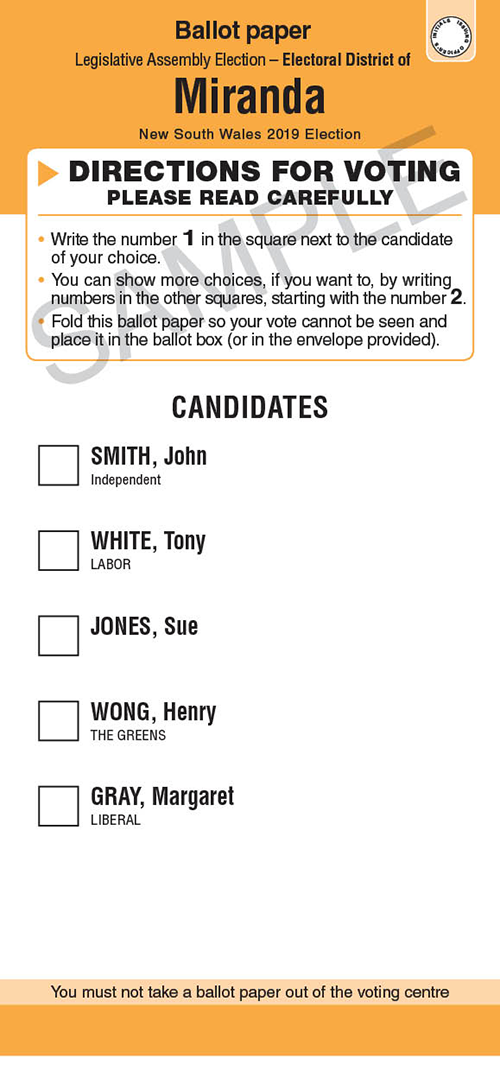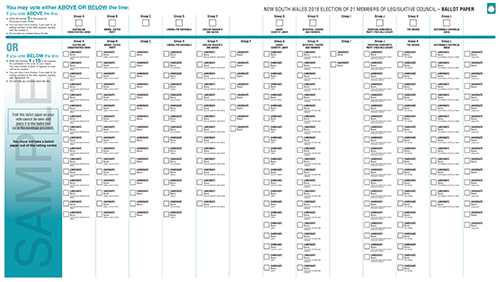How to cast your vote in a state election
At state elections, voters can elect members of:
the Legislative Assembly (the lower house of the NSW Parliament)
the Legislative Council (the upper house of the NSW Parliament)
When you vote in person at a voting centre at a state election, you will be given two ballot papers: a large one for the Legislative Council and a small one for the Legislative Assembly. At a state by-election, you will only be given one small ballot paper for the Legislative Assembly.
On this page
Legislative Assembly ballot papers
The NSW Legislative Assembly has 93 members. Each member represents one electoral district for a four-year term. Elections are held every four years using an optional preferential voting system. Each electoral district has a unique ballot paper, and you may only vote for the candidates running in your electoral district.
Before the election, the election manager for each district conducts a draw to determine the order in which candidates are listed on the ballot paper. Candidates names are pulled out of a ballot box at random; the ballot paper is printed with the name of every candidate in your district and their political party affiliation or the word "Independent" in the order in which they were drawn.
To vote, you must put a number 1 in the square next to the candidate you want to elect.
If you want, you can show more choices by putting a number 2 next to your second choice, then a number 3 next to your third choice and so on. It is up to you how many choices you show after your first preference.

Legislative Council ballot papers
The NSW Legislative Council has 42 members. Each member represents the whole state in Parliament for an eight-year term. Elections are held every four years using a proportional representation voting system; voters elect half the Legislative Council at one election, and the other half at the next.
The names of the candidates are shown on the ballot paper. If they are endorsed by a registered political party, the name of that party is also shown. If they are not endorsed by a registered political party or members of a group, they can choose to have 'Independent' printed next to their name in certain circumstances.
A 'candidate group' refers to at least two candidates who are listed collectively on a ballot paper as a group. This includes registered political parties and groups of candidates who have formed to run collectively. Groups may have a voting square above the line, allowing voters to vote for the entire group above the line.
Groups
The Legislative Council ballot paper has a thick line running across it, with group voting squares above the line and columns of candidate voting squares below it. The squares above the line allow voters to vote for all candidates listed in that group. The squares below the line list the candidates for each group individually in columns and also ungrouped candidates.
Before the election, the NSW Electoral Commissioner conducts a draw to determine the order in which groups and ungrouped candidates are listed on the ballot paper. Groups and the ungrouped candidates are pulled out of the draw at random; they appear on the ballot paper in the order they are drawn.
Below the line, the group candidates are listed in columns directly beneath their group voting square above the line. The group can choose the order they list their candidates below the line.
Ungrouped candidates
Candidates not included in a group are shown in a column or columns on the right-hand side of the ballot paper, and these are referred to as 'ungrouped' candidates.
Voting above or below the line
When completing your ballot paper, you must choose between voting 'above the line' or 'below the line'.

Above the line
You must put a number 1 in one of the group voting squares above the thick horizontal line on the ballot paper. By doing this you are voting for that whole group of candidates in the order they are listed below that square, starting from the top. This is all you need to do.
You can show more choices if you want, starting with the number 2 above the line.
If you vote above the line, do not put numbers in any squares below the line.
Below the line
You can vote below the line if:
you want to vote for candidates within a group in the order of your choice
you want to vote for candidates from different groups in the order of your choice
You want to vote for ungrouped candidates in the order of your choice
you want to vote for a mixture of grouped and ungrouped candidates.
You must put a number 1 next to your first choice candidate. Then you must put number 2, then number 3 and continue until number 15. You must choose at least 15 candidates below the line for your vote to be counted, but you can show more choices by putting more numbers if you wish, starting with the number 16.
If you vote below the line, do not put numbers in any squares above the line.
